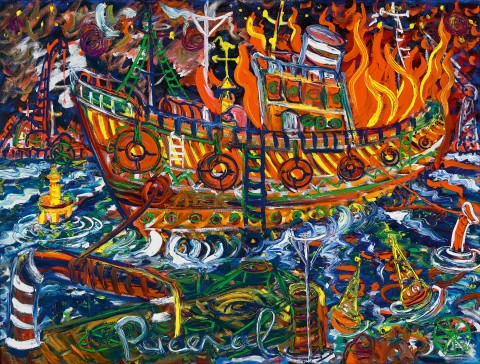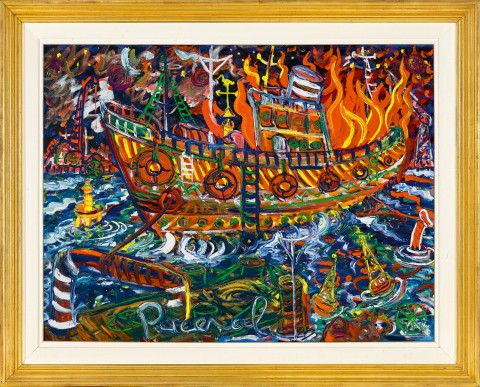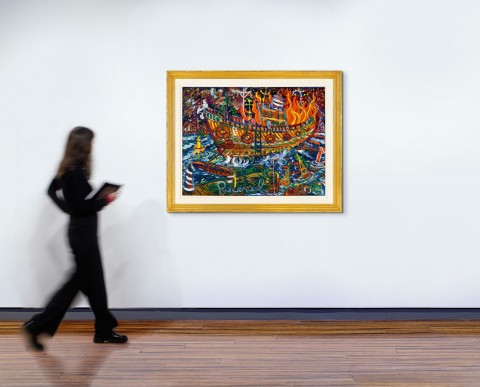THE BURNING OF THE ARK, c.1994
JOHN PERCEVAL
oil on canvas
91.5 x 122.0 cm
signed lower left: Perceval
signed and inscribed with title verso: Perceval / THE / BURNING / OF THE / ARK
Gould Galleries, Melbourne (label attached verso)
Private collection, Melbourne, acquired from the above in 1994
We are grateful to Ken McGregor for his assistance with this catalogue essay.
The final sequence of paintings created by John Perceval in the fifteen years before his death brim with an optimism and vitality at odds with the darkness of his previous decade as an institutionalised patient battling alcoholism and inner demons. With the support of friends and an artistic community genuinely excited to have him back in their midst, Perceval further benefited from the assistance of two carers, Ken McGregor and Matt Foster, who drove him to familiar locations to sketch before returning to the studio to turn these images into paintings. One particular favourite were the rotting wharves of Williamstown with their equally dishevelled ships and smoky air, a place that Perceval had first encountered in the 1950s with Charles Blackman. He subsequently painted two renowned sequences of the run-down dock in 1956-57 and again in 1959 before returning in the late sixties; and it is in these later works that the painterly strategies seen in The burning of the ark, c.1994, can first be detected.
In Arrival of the Lively Lady and The Floating Dock, Williamstown, 1967, for example, Perceval emphasises the turbulence of the waters with boldly individual brushstrokes which mark the shape of the swells as they rise and fall between battered, rusting vessels. Harbour Trust, Williamstown, 1967-1968, reveals a different strategy, one of whorls and curlicues which veil the sky and the sea with an agitation perfectly suggestive of a blustery day. The myriad of surrounding boats are painted in the jauntiest of colours indicating Perceval’s absolute delight at the encounter. The painter-critic James Gleeson accurately detected that the artist ‘loves the warmth or crispness of the air and evokes its quality with the exactness of an Impressionist and the feeling of an Expressionist.’1 In the later series, his assistant McGregor described how Perceval ‘likes the paint to swirl around the canvas and mix in with the other colours he has used. He uses, as well as his brushes, the end of the brush and sometimes his fingers.’2 In The Burning of the Ark, the yellow stripes on the hull recall those of the 1960s paintings, whilst the squiggles of paint where the ship meets the water almost ooze with the presences of the oil and diesel leaks that they no doubt represent. It is here and in the towering flames that aspects described by McGregor may also be detected, such as fingertips smudging through the original brush marks.
One final point is often overlooked, namely Perceval’s humour. Earlier Williamstown paintings had, for example, irreverent sailors urinating into the waters; but in The Burning of the Ark, the humour lies in Perceval’s interpretation of the actual events witnessed, described again by McGregor: ‘We were down at Williamstown looking at the boats and saw smoke coming from one of them; and John said ‘I hope there are no animals on board.’ I said ‘It’s not the Ark’, and the next day he painted the work. The funny bit about this story was that the smoke from the boat was someone actually having a barbeque.’3 Honoured with a retrospective at the Heide Museum of Modern Art in 1984, Perceval subsequently received the award of Officer of the Order of Australia in 1990 which officially acknowledged the dynamic contribution he had made to the art and culture of Australia.
1. Gleeson, J., Modern painters: 1931 - 1970, Lansdowne Press, Sydney, 1971, p. 95
2. Ken McGregor. Quoted in: Reid, B., Of Light and Dark: the art of John Perceval, National Gallery of Victoria, Melbourne, 1992, p. 32
3. Ken McGregor. E-mail correspondence with this author 12 July 2023. Perceval subsequently painted a different ship with the title The Ark (Noah’s Ark), 1994, exhibited at Gould Galleries, Melbourne, in 1996
ANDREW GAYNOR


